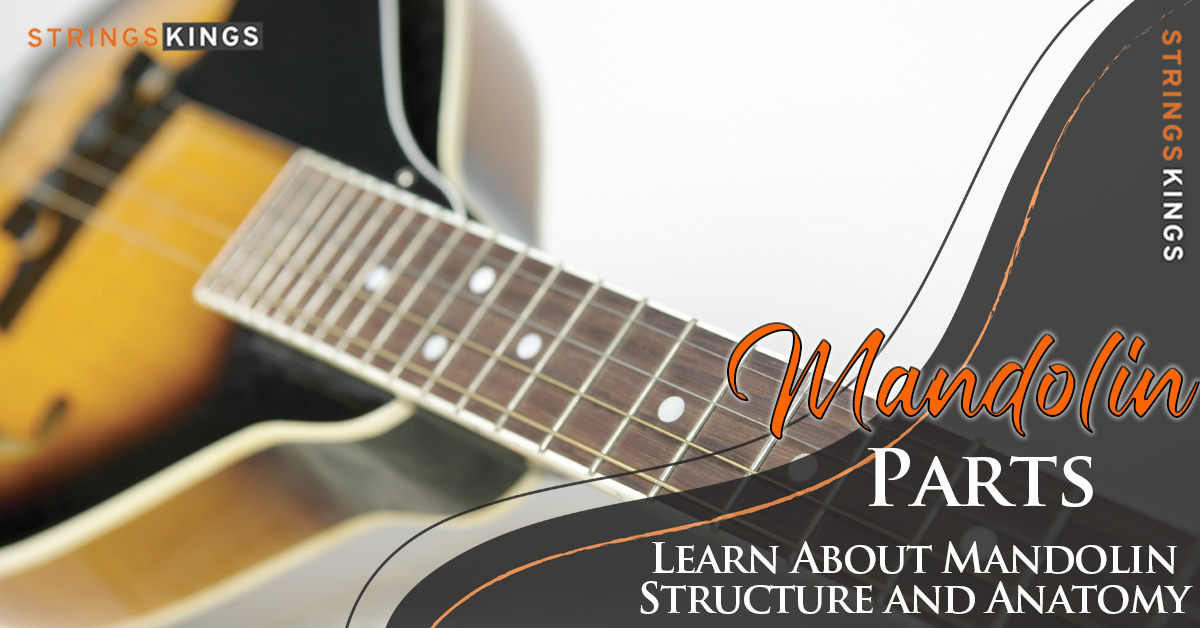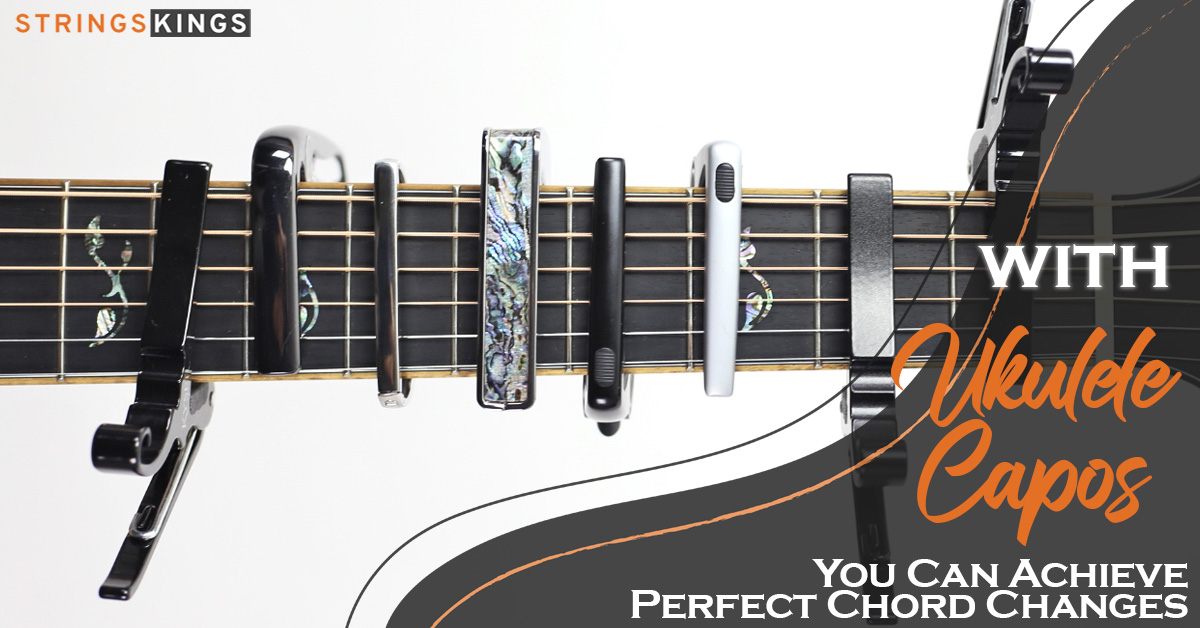Table of Contents
What is the Fastest Way to Tune Your Ukulele?
Every ukulele player should be able to tune their instrument. Nothing is more frustrating than strumming a nice chord in C major and having it out of tune! It’s time for tuning a ukulele!
Make sure you tune the instrument every time you pick it up when you are first learning how to play it.
You will find that your new ukulele will fall out of tune more quickly as the strings stretch, and you will see that tuning it less and less as time goes on.
In the following paragraphs, I will describe four different methods for tuning a ukulele. However, we must first determine what pitch each string is tuned to.
Tuning the Ukulele
There is no difference in tuning between a Soprano, a Concert, and a Tenor Ukulele – G C E A (From the string closest to you to the string closest to the floor).
We sometimes have low G strings (especially on Tenor) rather than high G strings, though even though the octave may differ, the G remains the same.
It is important that you memorize these note names in order to be able to tune each string to the proper pitch.
On both a piano and a ukulele, we can see where each note is:
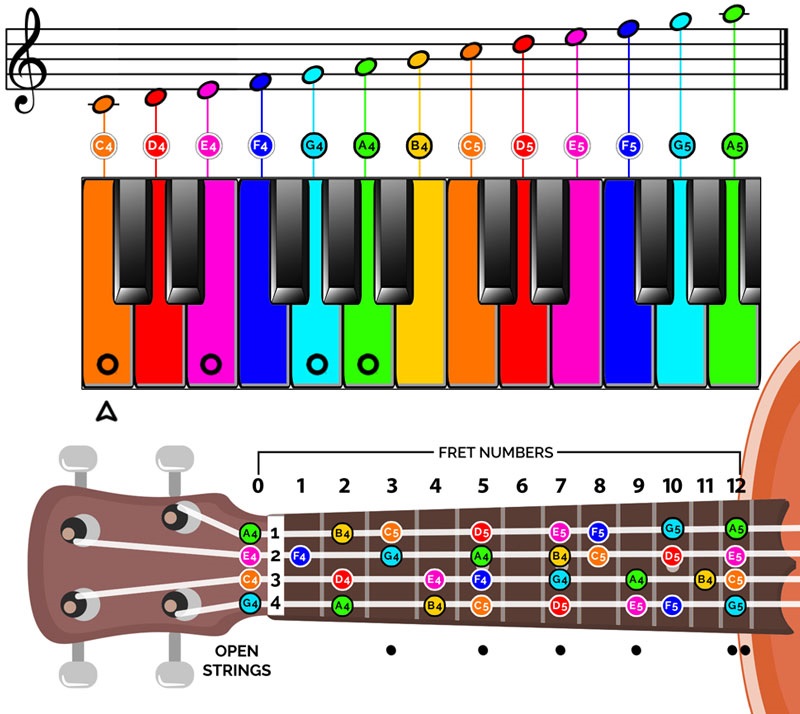
The Use of an Electronic Tuner for Tuning
Electronic tuners are the easiest and most effective way to tune ukuleles. There are standalone units and apps for computers and smartphones.
A microphone listens to the note, analyzes it, and shows you if the note is higher (sharp) or lower (flat) than what the string should be. We’ll walk you through tuning with an electronic tuner:
1. The G string should be open and ringing.
2. The needle in the graphic is to the left, meaning the note is a little flat.
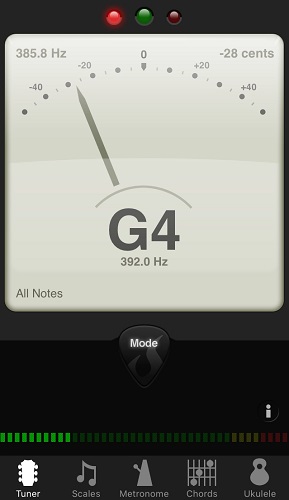
3. You will need to turn the tuner counter-clockwise on the G string (be sure to turn it a little at a time!)
4. Again, play the open G string

5. It looks like the tuning peg went sharp, so turn it clockwise
6. You can play the G string open

7. There is one string in tune!
Follow these steps for each of the four strings. No worries if it takes a bit; as with any skill, it will get easier with practice!
In order to make corrections, the tuners turn in the opposite direction for the E and A strings. Bringing the pitch up is done clockwise, and bringing it down is done counterclockwise.
Cross Tuning
People tuned for hundreds of years before smartphones, and there are still plenty of times when you won’t have a fancy electronic device and you’ll need an in-tune uke.
Cross-tuning, or tuning the uke to itself using fretted notes, is another method of accomplishing this goal. To determine whether the notes are sharp or flat, we will use our ears instead of an electronic tuner.
This will take some trial and error until you become accustomed to hearing the different pitches.
We would prefer to have a starting pitcher from another instrument or an electronic tone to tune the first (G) string, but if that is not possible, we can at least get the ukulele in tune with itself.
Tuning for the C String
When the G string is tuned, fret the fifth fret of the G string, which will produce a C. This is the same tuning we will use for our next string (if you are playing High G, it will be an octave lower).
Try playing the open C string and hear if the pitch is the same. If they are close to each other, you will hear a slight warbling sound, which is caused by the sound waves not quite lining up with each other. As the instrument is brought closer to the tune, the warbling will disappear. You’re closer to the correct note the slower those little beats are!
Depending on whether the note is sharp or flat (it’s okay to guess!) turn the tuning peg accordingly. Check the note again to see if they match.
How to Tune Your E String
To tune the E string, we’ll fret the 4th fret of the C string, which is the same pitch as the E. The same procedure should be followed for tuning the E string.
The Tuning of the A String
Last but not least, we have to tune the A string. You’ll find this note on either the 2nd fret of your G string or the 5th fret of your E string.
I’d like to point out that this isn’t the most accurate way to tune an instrument. As fretted instruments don’t always sound perfectly in tune because of the way the frets are laid out, you may find that the uke still sounds a little off after cross-tuning. Here’s where the next method comes in.
How to Tune by Ear (Intervals)
The last method that I like to use to tune ukuleles, is entirely by ear. We’ll tune the open strings by listening to the distance (or interval) between them.
Take time to learn, but you’ll have an in-tune instrument without an electronic tuner. Firstly, let’s look at how each string relates to the others:
- G -> C – Perfect Fourth
- C -> E – Major Third
- E -> A – Perfect Fourth.
Intervals: How to Hear Them
Since there are only two intervals to learn, this isn’t so bad, but how do we remember what they sound like? There’s a perfect fourth in the opening of “Here Comes the Bride”. Using your open G string, start singing the song on that pitch, and then use your open C string to match the pitch of the next note in the song.
Eventually, you won’t need to sing the notes because you’ll internalize the intervals, but it helps a lot when you’re starting. ‘When the Saints go marching in’ is the easiest way to remember Major third interval.
With just these two intervals, we’ll have our uke in no time. You can memorize these pitches even better by singing with your open strings: G C E A as you pluck them.
After a little practice, you’ll be able to tune using this method by just plucking the open strings one by one.

Does the tuning machine make a difference?
Ukuleles, especially sopranos, usually come with friction-tuning pegs. We’re used to guitar style or geared tuners. Each turn of a geared tuner spins the post a certain amount by going through a gear.
We might only turn the post 1/16th of the way around for every turn. You can tune much more precisely and easily this way.
It’s just like friction tuners on a violin, which provide a 1:1 ratio, which means for every turn the post turns one full turn too! If you move a friction tuner a little, you can change the pitch a lot.
Friction pegs can be great (and I use them on all of my instruments because they’re lightweight), but cheaper ones can slip on you and lose tune.
I highly recommend geared tuners on your first string instrument, especially if you’re new to string instruments.
Tuning a brand new ukulele: What do I do?
You just got your first ukulele and you want to play it but there’s a problem:
The instrument is out of tune. When you buy your uke from a store, it’s probably already tuned and all you have to do is follow the steps, but if you bought it online or had it shipped, it’s probably out of tune.
Here’s where things can get tough! Just getting one string tuned is half the battle.
Strings are generally loose and flat. For this purpose, you should use an electronic tuner.
A tuner will usually display a number next to the note you are playing.
On the ukulele, all of the open strings are in the same octave, so when we tune up the G string, we want our tuner to display “G4”.
It may be a much lower pitch and will require many turns on the pegs to reach the correct pitch.
It is normal for this to occur; repeat this process with each string and you will soon have an in-tune ukulele.
Are there alternative tunings available?
Despite the fact that we now tune our ukuleles to an open C6 chord, this was not always the case. Earlier in the history of the instrument, D tuning was just as popular (if not more so on soprano ukuleles)
It is important to note that while the intervals remain the same, the pitch of each note is raised by a whole step.
A D tuning would give us the notes A D F# B. You will still find this tuning used frequently among players (I keep uke in D tuning at all times rather than using a capo).
You will see a host of other tunings if you regularly refer to old sheet music or method books.
The starting pitch can vary, even though we are almost always tuning to an open 6th chord. The Eb (Bb Eb G C) and the F (C F A D) are also popular. Due to their shorter scale lengths, smaller instruments (sopranino and sopranissimo) are often tuned in F.
Having more than four strings on my ukulele, how do I tune it?
We will tune our 6-string and 8-string ukuleles to the same pitch as our standard ukuleles, but they will have what is called ‘Dual Course’ strings. In other words, there are two pitches instead of one. Work twice as hard and have twice as much fun!
Baritone Ukulele Tuning: How Do I Do It?
This tuning is the same as what we call ‘Chicago tuning’ on banjos or the top four strings of a guitar.
Although the notes are different, the relationship between them, intervals, is still the same.
All of the methods above will work the same as long as you know what notes your strings should be tuned to.
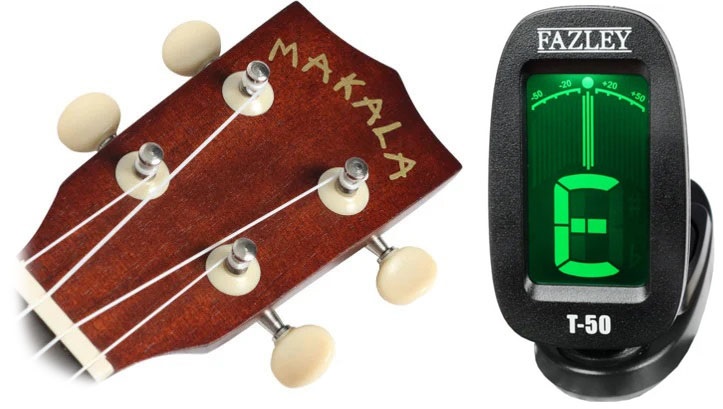
Final Thoughts
In conclusion, we hope that after reading our guide and experimenting with your instrument, you will now be familiar with the basics of tuning a ukulele with and without a tuner. Tuning your ukulele may seem difficult at first, but if you find the method that works best for you, keep practicing until you get it right.




